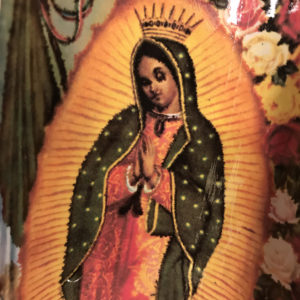December 12 brings the Feast of Our Lady of Guadalupe, sacred to all the Americas but especially to Mexico. The story begins in 1531 with Juan Diego, who was just a regular guy in Mexico. He saw an apparition of a woman on a hill near Mexico City, and she asked him to build a church in her honor there on the hill. She spoke to him in his native Nahuatl language and he recognized her, by the things she told him, as the Virgin Mary.
The iconic image of Our Lady of Guadalupe that we know so well miraculously appeared inside Juan Diego’s cloak on the 12th of December, 1531: on one of his visits to the hill, Mary told Juan Diego to go to the barren top of the hill, but when he got there, he found it not at all barren but awash with blooming roses. He and Mary gathered the roses and she arranged them inside his cloak. And on this, her feast day, Juan Diego opened his cloak before the bishop of Mexico City. When he did, the flowers all fell to the floor, revealing the image of the Virgin of Guadalupe. The bishop took it as a sign. The church was built, and the image from Juan Diego’s cloak, or tilma, hangs still inside the Basilica of Our Lady of Guadalupe on Tepeyac Hill, Mexico City.
The image on the tilma is considered miraculous by church doctrine, for many reasons. Some are more fascinating than others. My favorite has to do with the stars on Mary’s cloak: they appear only on her cloak; not on her tunic. But, if we superimpose the image from the tilma on an image of the stars in the heavens as they appeared on the 12th of December, 1531, they are said to correspond exactly with the constellations that day, and if her tunic and the rest of the image was filled with stars, too, they would complete the picture and on Mary’s head would be the constellation Corona Borealis: Northern Crown. Queen of Heaven? Perhaps. What is certain is that this is a day of festivity throughout Mexico and Latin America. And then tomorrow will bring the Feast of Santa Lucia, another midwinter gift bearer and a light in the darkness. If you have a Swedish bakery nearby, go look for Lussekatter––saffron buns in the shape of an S… they’re made especially for Sankta Lucia’s Night!
Image: Our artisan friends in San Miguel de Allende love Our Lady of Guadalupe and use her image on many of the things they make, including this painted tin tea light holder that we just began selling this fall.

Ah, the Virgin of Guadalupe, now this is a fascinating and complicated story. It’s not possible to understand Mexico without acknowledging the hold this saint has over the country. A very intelligent Mexican woman told me, with great conviction, that the 1979 infrared imaging revealed the reflection of Juan Diego in the Virgin’s eyes. In evaluating the historical accuracy of any story it is necessary to consider who wrote about the incident, and when. And also, who didn’t write about it, and when. Those who wrote about it did so long after the events, and many people who would have been expected to mention it at the time the events took place, did not. For example, Bishop Zumárraga, who has a prominent place in the narrative, never mentioned the events in his prolific writings. According to book artist Lois Morrison, the lack of historical record made her the perfect saint for Mexico, she could be imagined to suit their needs–dark skin, green & red cape, speaking Nahuatl, etc. Everyone has their own way of approaching this tradition. I have my own Virgin of Guadalupe miracle. The shrine is like a theme park with many displays and buildings spread over a large nicely landscaped area. When Steve & I visited in 2000, in a far corner, in a mostly overlooked souvenir stand, we found the last dozen (or so) copies of a FLEXAGON created to celebrated Pope John Paul’s visit in 1990!
A flexagon! Now there’s the perfect Ed Hutchins miracle!
Yes, there is some debate as to whether Juan Diego even existed. The tilma does, though, and I love the stories that go with it. Another of the miracles is that the tilma is made of a type of woven cactus cloth that should not have lasted more than a few decades, and here we are, nearly five centuries later. Thanks for commenting, Ed! I didn’t know you were a Convivio Book of Days reader… THANK YOU!
Thank you, John and Ed, for amplifying this beautiful tale. My photo postcard of the Virgin of Guadalupe is my most popular one. Always juxtaposed with an image of roses from the Owen Rose Garden, here in Eugene. It is said that the presence of the Virgin is always accompanied by the scent of roses, visible or not. That is a beautiful thought.
That is a beautiful thought, indeed, Paula!